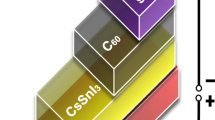Abstract
A thermal-electrical-mechanical coupled model was established to simulate the Parallel-gap resistance welding (PGRW) process between the Germanium-based solar cell and the silver interconnector. The simulated results showed that the peak temperature during PGRW is lower than the melting temperature of the base material. It is indicated that the connection mechanism of PGRW was mainly the interdiffusion and recrystallization due to pressure of electrode and the resistance heat. A detailed calculation method of current was proposed using semi-layered resistance model and layered resistance model. By comparing these models, it was found that the layered resistance model was more accurate to calculate the current value. The maximum residual stress was generated within the region under the welding electrode, while the maximum deformation was generated on the edge of the interconnector. The current variation trend predicated by the simulation results is in good agreement with the results obtained by the experiments.
Similar content being viewed by others
References
T. Schenk et al., A study on the influence of clamping on welding distortion, Computational Materials Science, 45 (4) (2009) 999–1005.
H. Fujii et al., 100-period, 1.23-eV bandgap InGaAs/GaAsP quantum wells for high-efficiency GaAs solar cells: Toward current-matched Ge-based tandem cells, Progress in Photovoltaics: Research and Applications, 22 (7) (2014) 784–795.
M. Hao et al., Developments in characterization of resistance spot welding of aluminum, Welding Journal-Including Welding Research Supplement, 75 (1) (1996) 1–4.
A. Afshari et al., Development and characterization of a resistance spot welding aerosol generator and inhalation exposure system, Inhalation Toxicology, 26 (12) (2014) 708–719.
W. S. Chang and S. J. Na, A study on the prediction of the laser weld shape with varying heat source equations and the thermal distortion of a small structure in micro-joining, Journal of Materials Processing Technology, 120 (1) (2002) 208–214.
J. A. Khan, L. Xu and Y.-J. Chano, Prediction of nugget development during resistance spot welding using coupled thermal–electrical–mechanical model, Science and Technology of Welding and Joining, 4 (4) (1999) 201–207.
S. Donders et al., The effect of spot weld failure on dynamic vehicle performance, Sound and Vibration, 39 (4) (2005) 16–25.
J. A. Khan et al., Numerical simulation of resistance spot Welding process, Numerical Heat Transfer, 37 (2000) 425–446.
I. Muneyoshi et al., Simulation of nugget size and residual stress of resistance spot welded HT980 steel sheet, Quarterly Journal of the Japan Welding Society, 29 (2) (2011) 86–95.
S. Kim et al., Study on the simplified numerical spot welding simulation by using the flexibility influence coefficient method, International Journal of Precision Engineering and Manufacturing, 14 (11) (2013) 1961–1968.
D. Zhao et al., Multi-objective optimal design of small scale resistance spot welding process with principal component analysis and response surface methodology, Journal of Intelligent Manufacturing, 25 (6) (2014) 1335–1348.
S. Hassanifard and M. Feyzi, Analytical solution of temperature distribution in resistance spot welding, Journal of Mechanical Science & Technology, 29 (2) (2015) 777–784.
X. Wan, Y. Wang and D. Zhao, Grey relational and neural network approach for multi-objective optimization in small scale resistance spot welding of titanium alloy, Journal of Mechanical Science & Technology, 30 (6) (2016) 2675–2682.
J. S. Kim, I. J. Kim and Y. G. Kim, Optimization of welding current waveform for dissimilar material with DP590 and Al5052 by Delta-spot welding process, Journal of Mechanical Science & Technology, 30 (6) (2016) 2713–2721.
D. J. Chmielewski et al., Metamorphic tunnel junctions for high efficiency III-V/IV multi-junction solar cell technology, 2013 IEEE 39th. Photovoltaic Specialists Conference (PVSC), IEEE (2013) 0882–0885.
K. Kensei and F. Katsushi, Crack-less electrical discharge machining of molybdenum with titanium electrode, Applied Mechanics and Materials, 510 (2014) 101–105.
J. Janczak-Rusch et al., Structural evolution of Ag-Cu nano-alloys confined between AlN nano-layers upon fast heating, Physical Chemistry Chemical Physics (2015).
Y. Liu, M. D. Deal and J. D. Plummer, High-quality singlecrystal Ge on insulator by liquid-phase epitaxy on Si substrates, Applied Physics Letters, 84 (14) (2004) 2563–2565.
Author information
Authors and Affiliations
Corresponding author
Additional information
Recommended by Associate Editor Young Whan Park
Xiaohong Zhan, who is born in 1979, is an Associate Professor in Nanjing University of Aeronautics and Astronautics, China. He mainly engages in welding process numerical simulation, laser welding and laser additive manufacturing, aerospace and other advanced manufacturing technology research work.
Rights and permissions
About this article
Cite this article
Zhan, X., Zhang, Q., Zhu, Z. et al. Numerical simulation of resistance welding of solar cell using a thermal-electrical-mechanical coupled model. J Mech Sci Technol 32, 269–276 (2018). https://doi.org/10.1007/s12206-017-1227-5
Received:
Revised:
Accepted:
Published:
Issue Date:
DOI: https://doi.org/10.1007/s12206-017-1227-5




